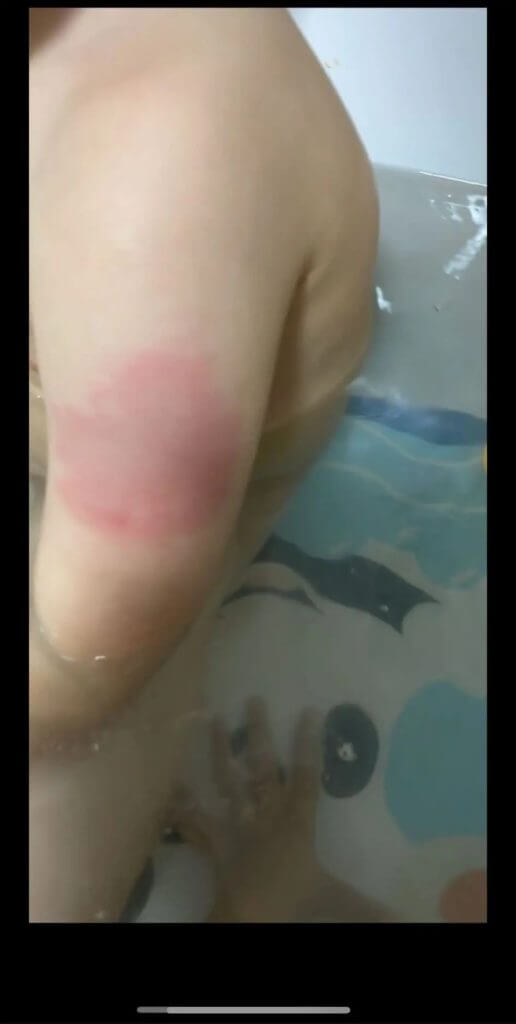
Swelling in the arm following the flu shot – a localized reaction
I would like to share a case I encountered in my office. One that I know, and have heard, that others have experienced as well.
We will try to analyze it together, from all sorts of different aspects.
The case is that of a localized reaction. In this case it presented in the arm but it can also present in the leg. It happened after the flu shot.
This case is dedicated to three cute little brother, two of them will be mentioned below.
What can we see in the image attached?
In the winter of 2022-2023, I vaccinated a cute little kid in my office with the inactivated flu shot.
One day later, he presented with redness and localized warmth at the site of injection, and the diameter of the lesion was a decent size, as you will see in the image attached.
There weren’t any other symptoms such as fever and it didn’t seem like the lesion was tender.
The swelling and redness resolved without any specific treatment, with or without warm compresses, about two days later.
What could this swelling, that presented following a flu shot, have been?
So let me start by saying that we do encounter cases like these.
It can happen after almost any vaccine, but it seems like there are certain vaccines that are more common culprits:
Bexsero – the bexero vaccine is the vaccine for meningococcus B and It is one of the more common vaccines to cause a localized infection, as I mentioned in the past in the my website. But while Bexsero may also cause a localized reaction, it also can cause a more systemic reaction with systemic fever. Other vaccines are limited to localized reactions.
Inactivated flu shot – this is the second most common vaccine to cause localized reactions, I see these about twice a year.
The vaccine containing tetanus (pentavalent, quadrivalent and trivalent) – I see it with these vaccines, here and there.
I am sure my colleagues will attest to seeing these reactions after any vaccine given by an injection.
And the question is – why does this happen?
Is it an infection?
Well. If someone would lick the needle through which the injection is given or roll it in an contaminated site, in the end, you would cause an infection to develop in the muscle where the vaccine was administered. But I must say infections following vaccines are very rare. Many providers see the swelling, warmth and tenderness and are unable to rule out infection and then recommend antibiotic treatment. I must say, however, that most of this time this is the wrong thing to do. So, I always recommend going for a pediatrician’s assessment, and I urge you to think, together with them, whether the presentation could be consistent with a bacterial infection, based on your prior experience, and whether antibiotics are truly needed.
Is it a bleeding?
It is not unreasonable to think that if the needle went through a vessel in the muscle, there could be some leakage of blood between the layers/fibers of the muscle. Indeed, a localized reaction of the body to a bleeding would also cause signs of localized inflammation, until the bleeding gets absorbed. Nonetheless, with bleeding we typically see a bluish colour in the skin and so I don’t think this is the reason for the reaction and swelling in the arm.
Is it necrosis of the fat layer?
Sometimes, when a short needle is used, it is unable to reach the muscle and the vaccine is administered into the fat layer of the skin, where it could cause necrosis and a reaction similar to this one. This is not the case here because the injection was administered deep into the muscle. Also, the flu shot comes in a preset injection vial that cannot be altered, so it is always the right length for the age of the patient.
Is it a localized immunologic reaction to one of the components of the vaccine?
That is likely the cause.
A localized reaction to the vaccine or one of its components is a known effect of vaccines. This can present in a spectrum of reactions, from a mild localized reaction, which is often seen after different vaccine administration, to a more severe one, referred to as Arthus reaction. Here, this was a moderate reaction but in true, severe arthus reaction the arm can develop a necrotic lesion.
In summary, a moderate localized reaction. It is not very pleasant, but it really isn’t that bad.
Ok Dr Efi, what made you think of this case from two years ago just now?
That’s a good question. Thanks for asking.
This year, in January 2025, I vaccinated the patient from the above image’s twin brother and a similar reaction developed.
This time it was mild.
Was this simply a coincident?
So, what are the final conclusions from this localized reaction to vaccines and what am I trying to say?
• It is important that providers (especially pediatricians and pediatric nurses) and parents be aware of this potential reaction
• Exceptional cases of severe localized reactions must be assessed by a medical professional. Most of the time warm compresses and some patience will lead to resolution of the symptoms but the reaction may last for several days.
• This, in my opinion, is not a reason to stop administering vaccines to this child. It is possible, though, that prior to giving a repeat dose of the same vaccine, the provider should give the case some thought.
For comments and questions, please register
